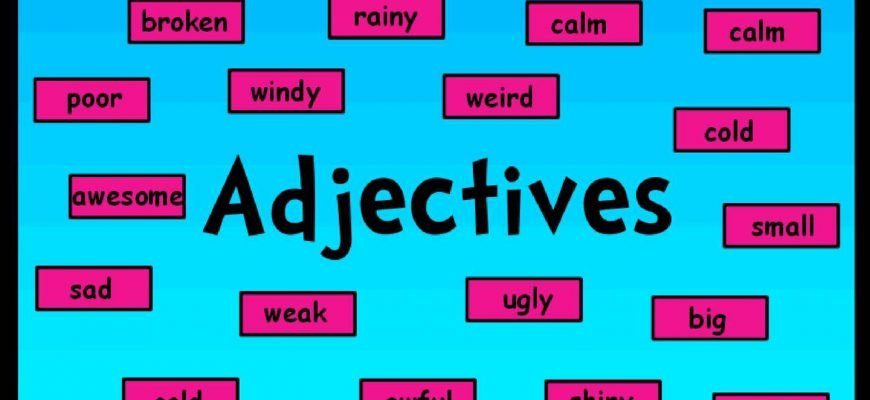Adjectives- Definition, Kinds with examples and order

Adjectives:
An adjective is a word that describes or modifies a noun or pronoun, providing more information about its qualities, attributes, or characteristics. Adjectives are used to enhance and add details to a sentence by expressing qualities such as size, color, shape, appearance, emotions, opinions, and more. Adjectives can be placed before the noun they modify (e.g., "a tall building") or after linking verbs (e.g., "She is intelligent"). They play a crucial role in language to bring depth and nuance to our expressions.
- When adjectives are used before a noun, they are called attributive adjectives.
- When adjectives are used after a noun, they are called predicative adjectives.
Kinds of Adjectives:
There are several types of adjectives that serve different purposes and describe various qualities. Here are some common kinds of adjectives:
-
Descriptive Adjectives ( Adjectives of Quality ): These adjectives describe the characteristics or qualities of a noun. Example: The tall tower, a beautiful sunset, a delicious meal.
-
Quantitative Adjectives: These adjectives indicate the quantity or amount of nouns. Example: Few friends, many books, several opportunities.
-
Demonstrative Adjectives: These adjectives point out or identify specific nouns. Example: This car, that house, these cookies, those books.
-
Possessive Adjectives: These adjectives indicate possession or ownership. Example: My phone, your book, his cat, her house, our team, their car.
-
Interrogative Adjectives: These adjectives are used to ask questions about nouns. Example: Which movie, what time, whose bag.
-
Comparative Adjectives: These adjectives are used to compare two or more nouns. Example: Smaller house, faster car, more interesting book.
-
Superlative Adjectives: These adjectives are used to indicate the highest degree or quality of a noun. Example: Tallest building, fastest runner, most beautiful garden.
-
Proper Adjectives: These adjectives are derived from proper nouns and refer to a specific person, place, or thing. Example: American culture, Chinese cuisine, Shakespearean play.
-
Indefinite Adjectives: These adjectives refer to non-specific or unknown nouns. Example: Some people, any opportunity, several options.
-
Ordinal Adjectives: These adjectives indicate the order or rank of nouns. Example: First place, second attempt, third chapter.
Degrees of Comparison:
The degree of comparison in adjectives is used to express different levels of comparison or intensity. There are three degrees of comparison: positive, comparative, and superlative.
-
Positive degree: The positive degree of an adjective is used to describe a noun without making any comparison. It simply states the quality of the noun. For example:
- She is a tall girl.
- The book is interesting.
-
Comparative degree: The comparative degree is used to compare two entities or qualities. It is formed by adding "-er" to shorter adjectives or by using "more" before longer adjectives. For example:
- She is taller than her brother.
- This book is more interesting than the previous one.
-
Superlative degree: The superlative degree is used to compare more than two entities or qualities, expressing the highest degree or quality. It is formed by adding "-est" to shorter adjectives or by using "most" before longer adjectives. For example:
- She is the tallest girl in her class.
- This is the most interesting book I have ever read.
It's important to note that irregular adjectives have different forms in the comparative and superlative degrees. For example:
- Good (positive), better (comparative), best (superlative).
- Bad (positive), worse (comparative), worst (superlative).
Transformation of degree of comparision:
-
Positive to Comparative:
- For short adjectives, add "-er" at the end of the adjective. Example: Positive - "tall," Comparative - "taller."
- For longer adjectives, use "more" before the adjective. Example: Positive - "beautiful," Comparative - "more beautiful."
-
Positive to Superlative:
- For short adjectives, add "-est" at the end of the adjective. Example: Positive - "tall," Superlative - "tallest."
- For longer adjectives, use "most" before the adjective. Example: Positive - "beautiful," Superlative - "most beautiful."
-
Comparative to Positive:
- Remove "-er" from the comparative adjective. Example: Comparative - "taller," Positive - "tall."
- Remove "more" from the comparative adjective. Example: Comparative - "more beautiful," Positive - "beautiful."
-
Comparative to Superlative:
- Keep the adjective and add "the" before it. Example: Comparative - "taller," Superlative - "the tallest."
- Keep the adjective and add "the most" before it. Example: Comparative - "more beautiful," Superlative - "the most beautiful."
-
Superlative to Positive:
- Remove "-est" from the superlative adjective. Example: Superlative - "tallest," Positive - "tall."
- Remove "most" from the superlative adjective. Example: Superlative - "most beautiful," Positive - "beautiful."
-
Superlative to Comparative:
- Remove "the" from the superlative adjective. Example: Superlative - "the tallest," Comparative - "taller."
- Remove "the most" from the superlative adjective. Example: Superlative - "the most beautiful," Comparative - "more beautiful."
Order of Adjectives:
When using multiple adjectives to describe a noun, there is a typical order in which they are placed. While there may be exceptions and variations, the general order of adjectives is as follows:
-
Determiner: This includes articles (a, an, the), demonstratives (this, that), possessives (my, his, her), and quantifiers (some, many).
-
Observation/Opinion: Adjectives that describe opinions or subjective observations about the noun, such as beautiful, delicious, interesting, etc.
-
Size: Adjectives that describe the size of the noun, such as small, large, tiny, etc.
-
Shape: Adjectives that describe the shape of the noun, such as round, square, rectangular, etc.
-
Age: Adjectives that indicate the age of the noun, such as young, old, new, etc.
-
Color: Adjectives that describe the color of the noun, such as blue, red, yellow, etc.
-
Origin/Nationality: Adjectives that denote the origin or nationality of the noun, such as American, French, Chinese, etc.
-
Material: Adjectives that describe the material the noun is made of, such as wooden, metal, cotton, etc.
-
Purpose/Qualifier: Adjectives that indicate the purpose, function, or qualifier of the noun, such as cooking, sleeping, professional, etc.
What's Your Reaction?


























































